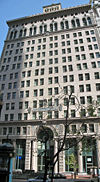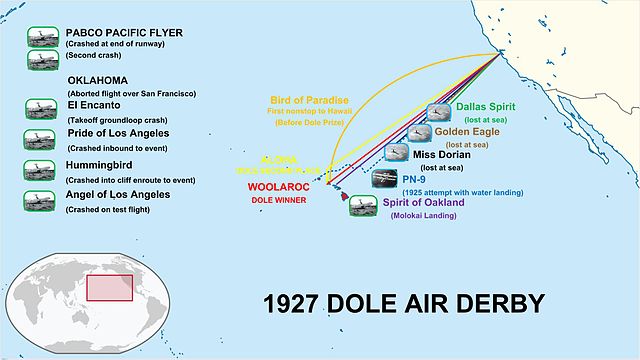- Dole Air Race
-
The Dole Air Race, also known as the Dole Derby, was a tragic air race to cross the Pacific Ocean from northern California to the Territory of Hawaii in August 1927. Of the 15-18 entrant airplanes, 11 were certified to compete but three crashed before the race, resulting in three deaths. Eight eventually participated in the race, with two crashing on takeoff and two going missing during the race. A third, forced to return for repairs, took off again to search for the missing and was itself never seen again. In all, before, during, and after the race, ten lives were lost and six airplanes were total losses. Two of the eight planes successfully landed in Hawaii.
Contents
The Dole prize
Inspired by Charles A. Lindbergh's successful trans-Atlantic flight, James D. Dole, the Hawaii pineapple magnate, put up a prize of US$25,000 for the first fixed-wing aircraft to fly the 3,870 kilometers (2,400 mi) from Oakland, California to Honolulu, Hawaii, and US$10,000 for second place.[1]
The Transpacific Record
The first transpacific flight had already taken place, twice over. On 28 June, about a month after Dole posted the prizes, Air Corps Lieutenants Lester J. Maitland and Albert F. Hegenberger flew a three-engine Atlantic-Fokker C-2 military aircraft from Oakland Municipal Airport to Wheeler Army Airfield on Oahu in 25 hours and 50 minutes. Ernie Smith and Captain C.H. Carter had arrived earlier for the attempt, but due to mechanical difficulties, took off two hours after Maitland, and returned with a broken windshield. Carter quit after the record was lost, but Smith hired Emory Bronte as a navigator, and the City of Oakland, a small Travel Air 5000 civilian monoplane, took off again on July 14th. [2] Upon running out of fuel 26 hours and 36 minutes later, they crash-landed in a thorn tree on Molokai. Dole disqualified both of them from his prizes because they did not land in Honolulu (The Air Corps flight had been planned months prior to the prize announcement and had no intent to land other than at Wheeler).
The Dole Air Derby
The race began on 16 August 1927. The fifteen competitors were seen off by a crowd estimated to include 75,000 to 100,000 persons.
The drawing for starting position in the Dole race was held on 8 August in the office of C. W. Saunders, California director of the National Aeronautics Association, in the Matson Building in San Francisco, California.
Two days after the drawing, United States Navy Lieutenants George D. Covell and R. S. Waggener took off from San Diego, California in their Tremaine Humming Bird, to fly to Oakland, flew into a fog bank, crashed into an ocean cliff, and died. The next day, Arthur V. Rogers took off for a test flight at Western Air Express Field at Montebello, California, circled, came about to land, suddenly dived into the ground, and died.
Meanwhile, Mildred Doran, Auggy Pedlar, and navigator Manley Lawling were flying into Oakland when their aircraft developed engine trouble. They successfully landed in a wheat field in the San Joaquin Valley, but had trouble making repairs because they no longer had any tools. Doran was quoted as stating, "We threw [the tools] off at Long Beach because they were in the way and cluttering things up." Lawling was later replaced by Vilas R. Knope when Lawling could not satisfy the race committee of his navigational skills. He reportedly got lost over Oakland.
Then, on 11 August, as J. L. Giffin and Theodore S. Lundgren approached Oakland, their aircraft, an International CF-10 Triplane, the Pride of Los Angeles, crashed into San Francisco Bay. The two men were unhurt, though.
By 16 August, the starting lineup had diminished to eight:
- Woolaroc, a Travel Air 5000, NX869, flown by Arthur C. Goebel and navigated by William V. Davis Jr.
- Aloha, a Breese-Wilde 5 Monoplane, NX914, flown by Martin Jensen and navigated by Paul Schluter
- El Encanto, a Goddard Special metal monoplane, NX5074, flown by Norman A. Goddard and Kenneth C. Hawkins, which was heavily favored in the pre-race odds
- Oklahoma, a Travel Air 5000 sister ship of Woolaroc, 'NX911, piloted by Bennett Griffin and navigated by Al Henley
- Pabco Flyer, a Breese-Wilde Monoplane, NX646, flown alone by Livingston Gilson Irving
- Golden Eagle, the prototype Lockheed Vega 1 monoplane, NX913, flown by Jack Frost and navigated by Gordon Scott
- Miss Doran, a Buhl CA-5 Air Sedan, NC2915, flown by Auggy Pedlar, navigated by Vilas R. Knope, and carrying Mildred Doran
- Dallas Spirit, a Swallow Monoplane, NX941, flown by William Portwood Erwin and navigated by Alvin Eichwaldt
The initial take offs were plagued with trouble. Just before 11am, Oklahoma took off. The crew would eventually abort the flight over San Francisco. She was followed by El Encanto, which had not cleared the runway before she swerved and crashed. Pabco Flyer lifted momentarily into the air, then crashed some 7000 feet from the runway. Their crews were not hurt. Golden Eagle took off smoothly and flew out of sight. Miss Doran succeeded in taking off, but circled back and landed less than ten minutes later. Then Dallas Spirit returned to Oakland. Aloha and Woolaroc took off uneventfully, and Miss Doran succeeded on her second attempt. Pabco Flyer also tried and crashed a second time.
Woolaroc won the race in 26 hours, 17 minutes, earning Goebel and Davis US$25,000. Aloha arrived in 28 hours, 16 minutes, earning Jensen and Schluter US$10,000. Neither Golden Eagle nor Miss Doran were ever seen again.
The search for the Golden Eagle and Miss Doran was aided by three submarines, USS R-8 , USS S-42 , and USS S-46 . After repairing Dallas Spirit, Erwin and Eichwaldt joined the search leaving Oakland for Honolulu. They were never seen again, either.
Woolaroc has survived and is on display at the Woolaroc Museum in Oklahoma.
References
- ^ "Dole Derby". http://hawaii.gov/hawaiiaviation/aviation-photos/1920-1929/dole-derby/ha_photo_album_view?b_start:int=0&-C=. Retrieved 23 August 2011.
- ^ . July 1967.
- Conant, Jane Eshleman (October 10, 1955). "Death Dogged the Dolebirds: Pioneer Pacific Fliers Wrote Tragic Chapter in Air History". San Francisco Call-Bulletin. http://www.sfmuseum.org/hist10/27dolerace.html. Retrieved September 12, 2010.
Forden, Lesley, The Glory Gamblers, The Story of the Dole Race, 1971 p.90.
Further reading
- Gary W. Hyatt (October 2009). Winners' Viewpoints: The Great 1927 Dole Race. Oldairfield, LLC.
- "Arthur C. Goebel". Davis-Monthan Airfield Register Website. November 2009. http://www.dmairfield.org/people/goebel_ac/index.html. Retrieved September 12, 2010.
← 1926 · Aviation accidents and incidents in 1927 · 1928 → Aug 16 Dole Air Race
Aug 22 KLM Fokker F.VIII
Aug 31 Loss of St Raphael
Incidents resulting in at least 50 deaths shown in italics. Deadliest incident shown in bold smallcaps. Categories:- Air racing
- Aviation awards
- Challenge awards
- History of the Pacific Ocean
- History of Honolulu, Hawaii
- 1927 in the United States
- Aerial disappearances
Wikimedia Foundation. 2010.


